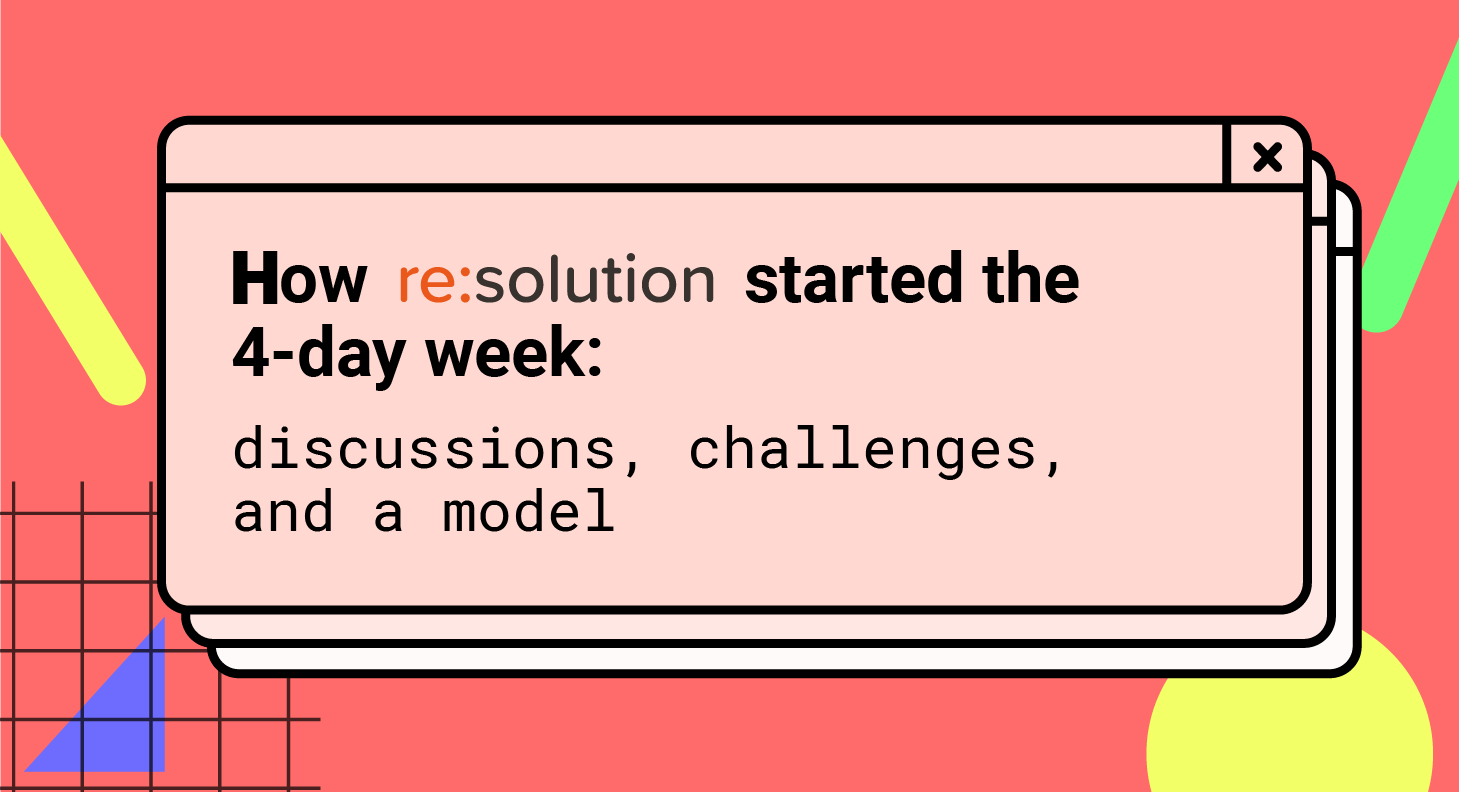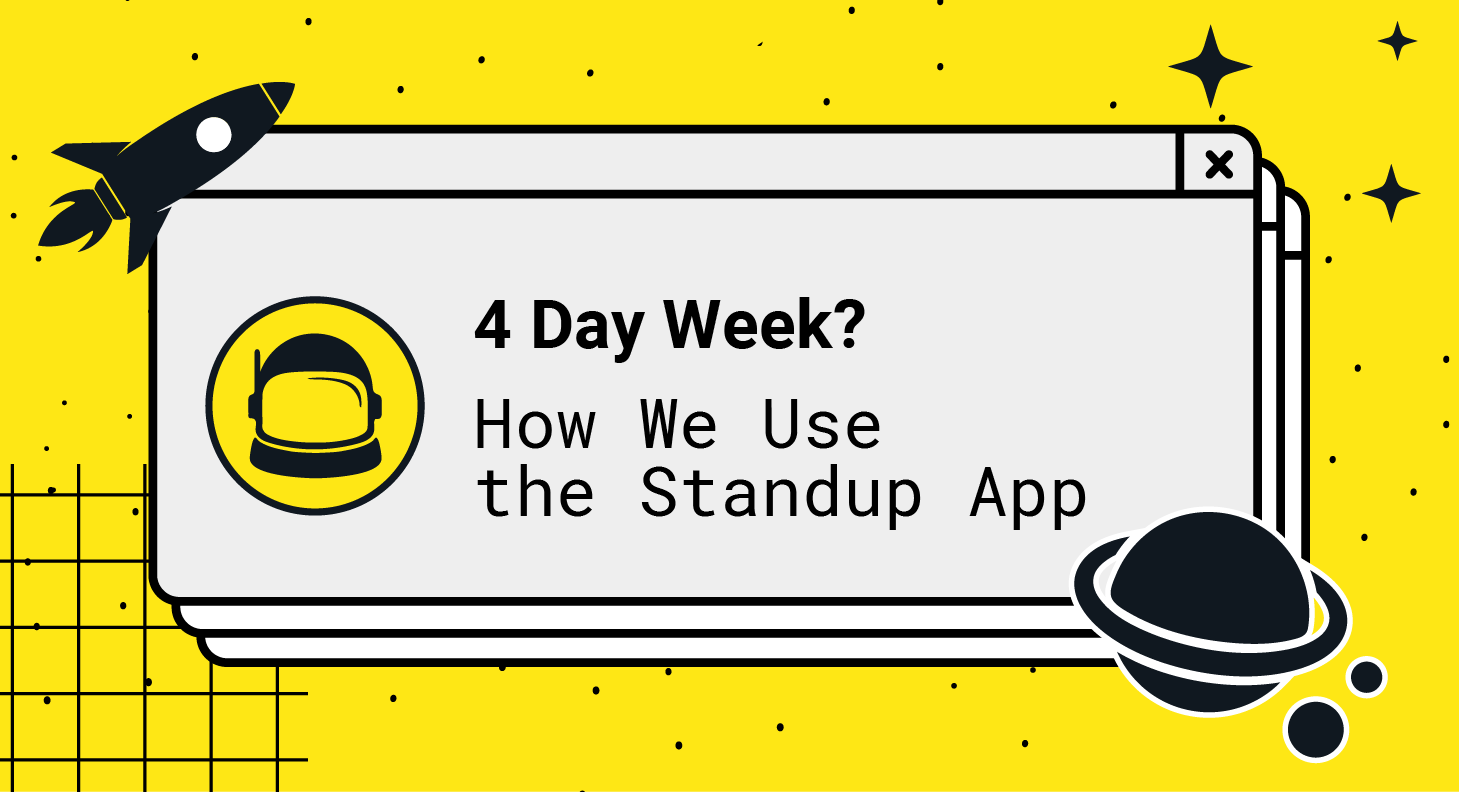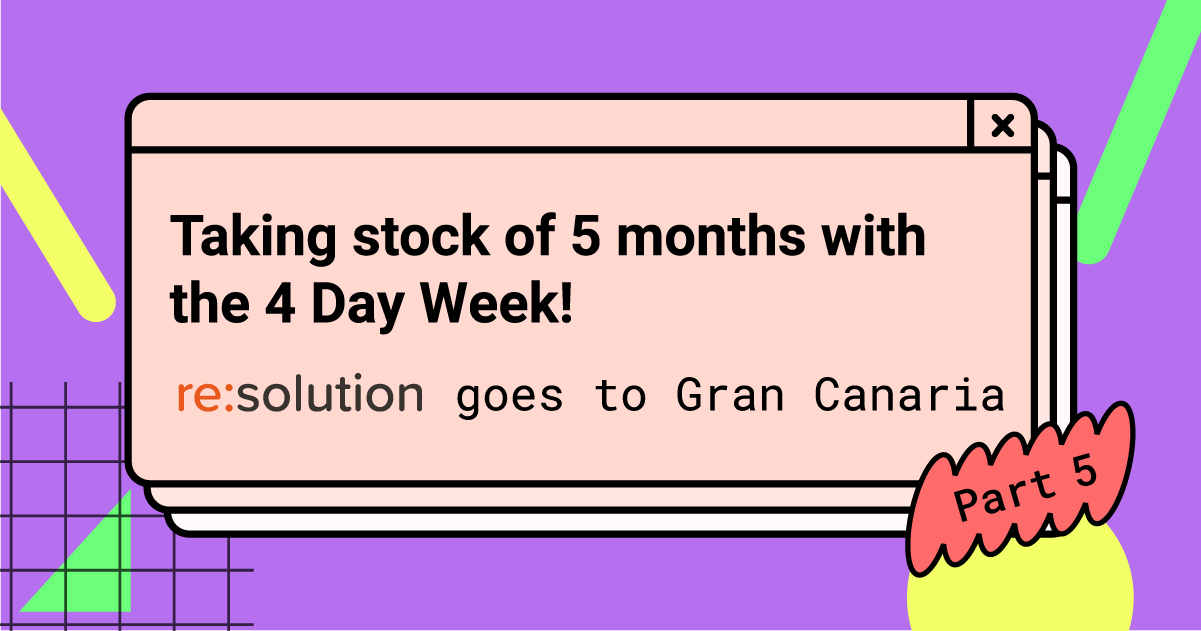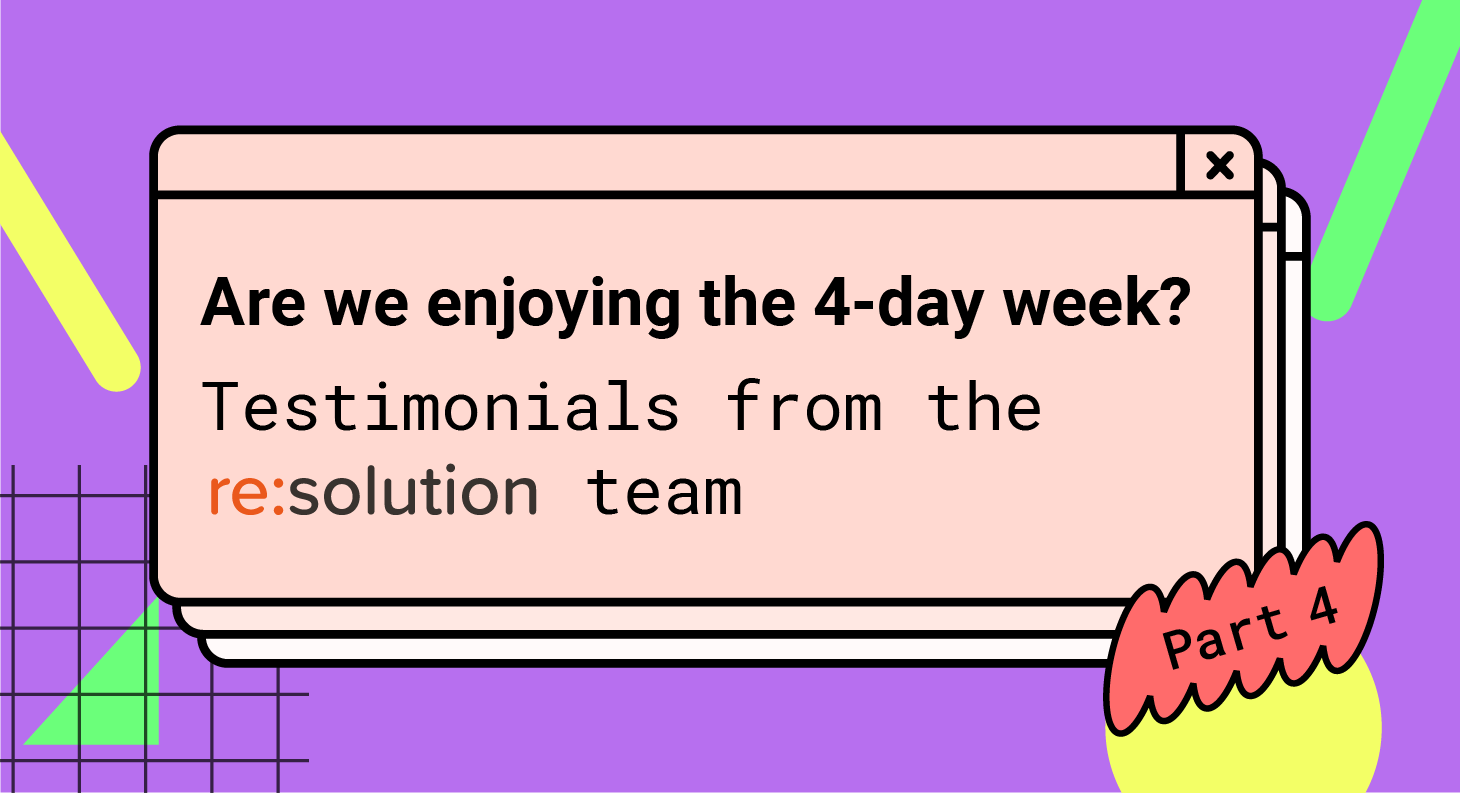This article is the first of a series that describes our journey into the future of work. Subscribe at the bottom to get notified as we share the next episodes!
How it began
Yes! We’ve started a trial of the 4-day week
It’s the first thing I tell everyone I meet. Actually no, my wife usually leads with it when we see friends and family.
Jaime’s company is trialing the 4-day week! And with no pay cut!
Of course, we’re not the pioneers, which is very reassuring. There’s increasing evidence that companies trying the 4 day week see improvements not only in employee motivation and retention, but also overall productivity and growth. The Icelandic experiment, conducted between 2015 and 2019, is possibly one of the most comprehensive experiences. It affected about 2,500 government employees who saw benefits in 8 different factors including work-life balance, easier to do errands, and participation in home duties. Another of the first reported experiences happened at the Japanese offices of Microsoft in 2019, which reported a 40% increase in productivity.
So how did it all start for us?
It all started as a joke
What about the 4-day week, are we giving it a chance?
It was almost a recurring joke, made in the same tone as the announcement that the company would still not be giving out Teslas in spite of exceeding expectations for the quarter.

After all, resolution has been an Atlassian Marketplace Partner since 2013 (the year when our flagship product, SAML SSO, was released). The company has a typical ecosystem culture: a mindset of collaboration above competition, a very flat structure where everyone has a high sense of ownership, and complete flexibility in how employees manage their time. 9 to 5 hours are long gone and requests for time off are a mere formality. When I need to go to the dentist or attend any other appointment, I simply inform my team mates that I will be unavailable at a certain time.
Keep reading about the 4-Day Week
The 6-hour long Town Hall debate
In that context, a 4-day week still sounded as in any other company – too good to be true. But also, a bit unnecessary.
Until that debate.
In June 2022, the entire team met in person in Berlin for the first time since the pandemic. For me, having joined the company in May 2020, it was the first time seeing many people in person.

Most of us didn’t have the 4-day week topic on the radar, so it came as a big surprise when our Co-Founder and Co-CEO Christian Reichert opened with it on the third day.
As Chris puts it:
“We’re not equally productive all the time. At least, I know that I’m not. There’s certain days when I come into the office and realize that it’s not my day, and then it’s best for me to do something else than what I had planned. I can do the groceries, review documents, or just do anything that will be a better use for my time on that day. One of the big questions for us in trialing the 4-day week is whether we can find a formula that supports everyone in coming up with their own unique ways to find focus, stay productive, but also ultimately be happier”.
The discussion took the entire morning, and then some. It could have taken longer, had I not interrupted to ask for a lunch break so I could meet a friend who had been waiting for me downstairs for over 40 minutes. Thanks for your patience, Otto!
As the debate started, there was no commitment with any outcome. Instead, the aim was to have a frank discussion, as such a change would radically affect everybody’s day-to-day arrangements.

Given the small size of the team, with only about 25 people, Chris and Björn (the two co-CEOs) used the opportunity to get everyone’s input and asked for open feedback before trying to frame the conversation more narrowly.
Many questions for just as many preferences
Would you like to be on a 4-day week? Would it improve anything in your life in comparison to the flexibility that you already enjoy? How would you use it? Would it help you stay productive? Would you be fine with having a fixed day for everyone (for example Friday) or would you prefer to choose?
These were some of the questions that the team answered. We all recognized that we already have the privilege to be our own bosses with regards to how we schedule our days. And still, all of us saw the huge benefit of having a day to disconnect and recharge our energy.
To me, the 4-day week felt like losing 10 years
For me as a father, having a day off work while kids are at school would free up real “me” time. I imagined myself going to workshops, building analog synthesizers, getting fit. Or simply reading! Meeting friends! All of those parts of my life that had almost vanished since I became a caregiver could come back. I’d be 28 again.
Tensions in the debate
Of course, not everybody had the same motivations, and the angles and details that were discussed would fill up a ten-page protocol. To give an example, a clear spread opened up between parents and colleagues with no kids. For us parents, non-working time is filled up with family chores, and personal time is something we don’t enjoy on weekends. Also, we can feel guilty at times when appointments related to our kids become frequent.
Regardless of where anybody stood in the debate, one of the major points in the discussion was whether having a day off would allow to handle appointments/chores better and still disconnect – or if it was better to just have flexibility.
The tension was there. As we listened to each other we discovered that we were not willing to trade our flexibility for the additional day. We wanted to keep it, and also shave a 20% off the working time.
Was that even an option? And what needed to happen to make it a real option?
A mission and a plan
Chris started laying down the idea of a plan.
If we want to work a 20% less, we need to be more productive than we are right now. Let’s be honest. We’re not the best at using the collaboration tools that we have. We probably have to get better at documenting, at working asynchronously, and also get ready for situations in which many colleagues won’t be available to discuss anything in a meeting, because it’s their day off.
At that point in the debate, we were on a mission together.
The mission statement was clear: We have to transform our way of working so that we can work one less day, and we have to make sure that we don’t lose productivity.
There was an even more basic question: how the hell do we know how productive we are? We needed to get an idea of how much is delivered before we can make any assessments on the impact of the new schedule.
Risk number one: What if the company fails?
Working at resolution is a fun ride. We definitely don’t want to sink the ship because we’re too lazy to work hard, so we need to find ways to work smarter, not harder.
After all, as many companies in the ecosystem, we’re doing good now but we do have challenges and a clear mandate to innovate and diversify our business model in the next few years. We can’t lose touch with reality.
Risk number two: What’s our Cancel Culture?
If we see clear signals that the new model is not working, we’ll have to terminate the experiment. Even though that sounds straightforward enough, Chris was still concerned about the impact of such a drastic decision for the team.
How would you feel if we eventually have to cancel?
Yes: the question that took longer to discuss was about feelings. We went through the circle and everyone answered, always in a reassuring tone: “it makes sense, we’d understand”. We’re used to doing experiments, and we often cancel. But Chris insisted. He knew that it’s one thing to understand with your brain. It’s very different to accept with a full heart.
Will you hate me if and when I pull the plug? This is not a new right that no one can take away from you. It can be cancelled if things don’t work out, but if that happens we’ll share enough evidence that we need to go back, and if it will only be after we can say that we tried hard enough”.
The answers didn’t change. Well, many did recognize that they’d probably be disappointed. As we insisted that we’d be fine yet sad to go back, we were silently committing to change. We’re going to try, we’re going to be the best version of ourselves, and we’re going to succeed!
The decision: let’s try!
That was it. Having gauged the feeling and everyone’s commitment to change, we decided to give the 4-day week a chance. It was hard to say who decided, or what was decisive. In the morning Chris had admitted that he was torn and had concerns. In the afternoon, we had gone through each and every concern as a group. He closed the topic thanking the team for speaking up frankly.
September 2022 was the initial horizon for starting the experiment. But we still needed to transform the idea of a plan into a full-fledged model.
Designing our model of a 4-day week
The 100/100/80 rule

For us, the concept of the 4-day week is intriguing because at its core it has the premise of delivering the same outcomes (100% productivity) at the same cost (100% salary) to us but in 4 days instead of 5 days (80% time). Leaving one day a week to have additional time off for ourselves, our families, etc which leads to further improvements in work-life balance and overall happiness. That’s why we provide this re:st day.
This is how our 4-day week manifest starts. It already answers most of the comments that I get when I tell friends and family. I think the most common reaction is: “So you’ll have to work 12 hours a day instead of 8?”, followed by the question of whether we’re getting our full salary.
The manifesto also positions our 100/100/80 model of a 4-day week in opposition to others.
- Many Swedish companies work 6 hours per day, five days per week. Swedish nurses also have this schedule. While this is a great model, it doesn’t work for us: we do need an overlap every day to work with our Brazilian colleagues, so afternoons are critical.
- Some have come to the extreme of trialing 25 hours per week (link is in German), but at the expense of cutting every pause, social interaction, coffee time, etc. Not cool with us.
- We definitely stand in disagreement with most companies in the UK, as only 1% intends to maintain full pay to 4-day employees.
- And we also don’t see the benefits of a 4/10 compressed workweek. Working very long hours does not translate in quality work!
The list doesn’t stop there. 4/36, x/32, 4/40. I’m sure they work for someone else, but it’s not us. We’re getting the same salary and we’re expected to work 32 hours per week, for four days a week. No more. If you’re familiar with the project management triangle, the inevitable consequence of diminishing the time by 20% should be that productivity decreases accordingly. That’s exactly what we want to challenge.
That being said, the 100/100/80 is a very broad umbrella with room for multiple different implementations. Here are some of the additional factors that are part of our final model:
Collaborating and measuring output with Atlassian tools
For the last 10 years, re:solution has defined itself as an Atlassian Marketplace partner. The 4-day week is a unique opportunity to change our working habits with Jira and Confluence, and “Unleash the potential of every team”, following the Atlassian motto.

In particular, an intensive adoption of Jira must become the foundation for both collaborating and measuring our productivity. For the first time we’re happily chanting: “If it’s not in Jira, it doesn’t exist!”. We are replacing Slack DMs with comment threads, measuring our team velocity, and other metrics that we’ll discuss in the next article.
A bottom-up approach
Being a small company with only 4 teams is a luxury! Each team can decide how they want to collaborate, as long as they are accountable for their work. For example, some teams (including marketing!) have adopted Scrum. Others a simpler Kanban board.
This is precisely the opposite direction most corporations go when they implement Jira at scale and force every team to adopt a standard workflow.
Freedom to choose the re:st day

Instead of having a mandatory free day every Friday, each employee at re:solution gets to choose between three options: Monday, Wednesday, and Friday. Whatever the choice, Tuesday and Thursday remain as the core days to ensure that there is still enough room for face-to-face interactions.
Some prefer to work on Fridays, as less meetings mean getting more done. Some prefer to split the week in two by taking Wednesday off. Some prefer to start the week on Tuesday. Besides being bottom-up, this model also produces shifts naturally, so that no customer requests or emergencies are uncovered for.
Obviously, there are also some disadvantages: besides having less opportunities for synchronous communication, Tuesdays and Thursdays tend to be packed with meetings.
All teams are included!
Bottom-up works for individuals, but also for teams. Every team must find the right approach to collaboration, and there is not one-size fits all methodology for how we collaborate.
One of the software teams has decided to all take Friday off and be on call for emergencies; marketing has adopted sprints with story points, but the story points are not comparable with those of other teams. The business meaning of Jira epics is different for every team.
There’s still room for socializing

Other implementations of the 4-day week aim at increasing effective working time by removing idle moments, coffee chit chats, or social media scrolling. That doesn’t work for us. We see our colleagues as a second family, and we want more time, not less, to socialize.
Chaos is the dark side to our culture
If you’ve read so far, you probably know that we cherish our freedom, and that there is no hint of micromanagement in how we work. What a great culture!
Well, I agree that it sounds magical (and it also feels a bit unreal). It comes at a cost, though: we’re a bit chaotic. Our scale means that chaos doesn’t really become unmanageable, but it’s still the number one risk to our productivity.
Before looking at what we’re doing to change our culture, it’s probably a good idea to quickly describe our baseline: Who are we? Where do we work from? And how do we collaborate?
Yes, we’re a (more) diverse company (than we used to be)
re:solution has two offices, located in Berlin and the southern German region of Saarbrücken, very close to Luxembourg. However, the team is far more diverse than what those locations suggest. In October 2022, there were remote employees based in Brazil, Slovakia, Poland, and Spain, with a quite long list of nationalities adding also South African, Egyptian, Mexican, Ukrainian, and Chinese. Not too bad for a company that started as a personal spin-off and was originally just white German guys.
Unstructured meetings
With the team being so spread, we do have a culture of working remotely… with way too many unstructured meetings and a lot of real-time messaging in Slack.
It’s not uncommon to start meetings late, to change topic throughout the session, or to spend the first 15 minutes of the call reconstructing the context for the discussion. Longer meetings can have meanders: when somebody makes a question or asks for support, we may go into a hands-on session to answer and troubleshoot; and by the time the meeting is over, we rarely have notes of the discussion that can be used in follow-ups.
Jira tickets for Jira haters
There is nothing worse for a company that relies on Jira than a ticket with only a short summary, and no description.
We didn’t have one – we had hundreds, particularly in business teams where descriptions are usually more mundane than technical and are often left out because they seem obvious in the fleeing moment. Picking up work from our marketing backlog was often times impossible because of that. We often needed to discuss the topic again in a meeting, do a bit of archaeology in Confluence…
What is Confluence for?
Our internal Confluence is not really a wiki: it’s rather a collaborative text editor, with few references and articles for guidance.
We’re aware that good documentation is a strong foundation for async collaboration: instead of requesting a meeting and asking in person, most information on how to accomplish a task should be available on the wiki.
Next: What changed before launch?
A lot needed to change, but where to start? Surprisingly, change started in Marketing.
In the next article we will share the details of how we prepared for the 4-day week, including:
- How we measure productivity using Jira and additional tools
- How different teams found different solutions, while still aligning to our 100/100/80 model
- How we gauge the team moral and satisfaction, both before and after starting the trial
- And what challenges are we still working on
Subscribe below so you don’t miss it!








